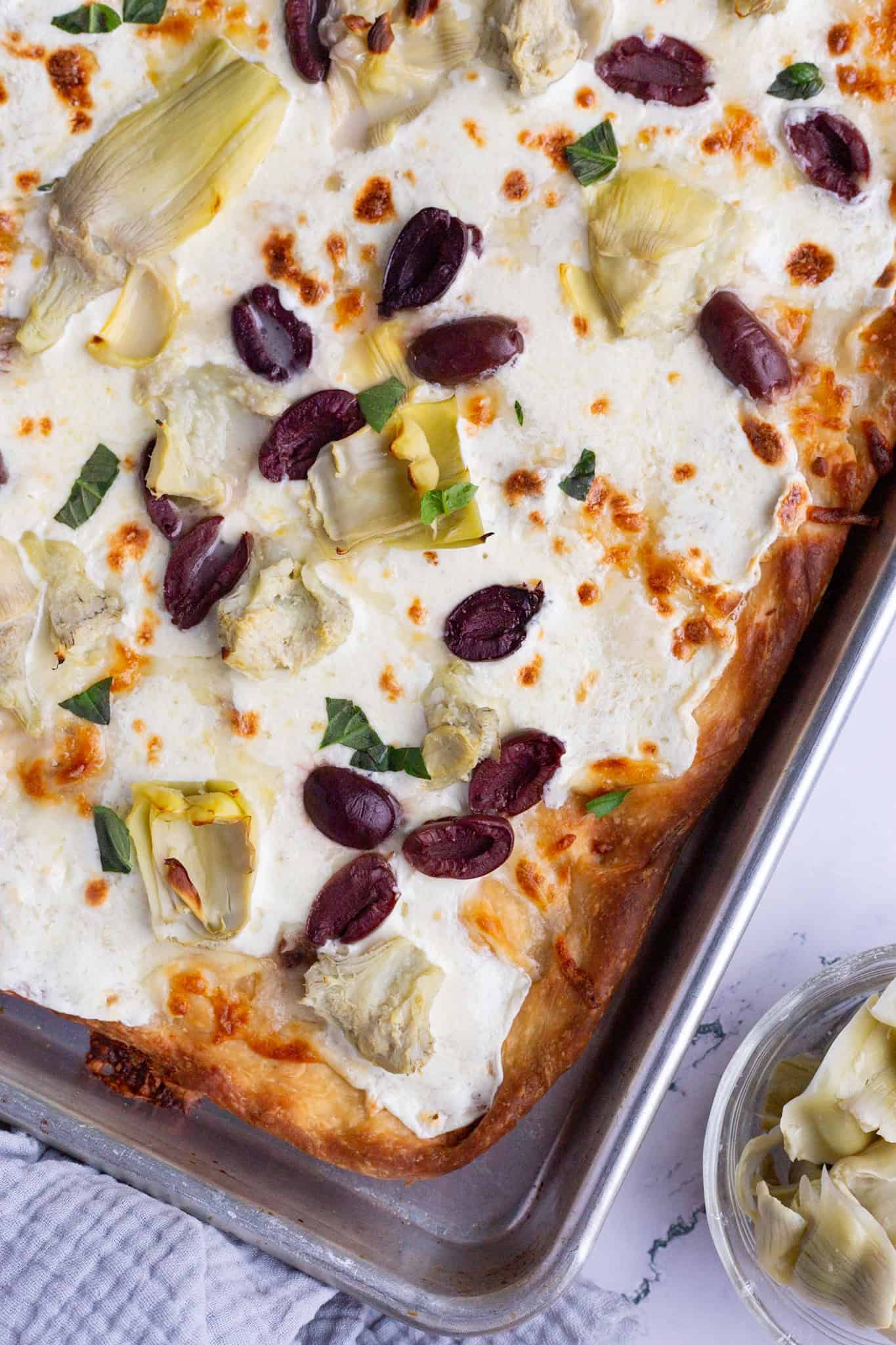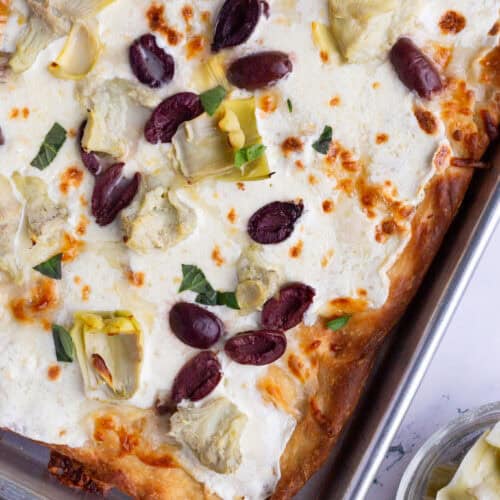Black Olive Pizza
Homemade pizza is surprisingly easy to make, and this black olive pizza is no exception. The crust requires just a few ingredients–and some patience–and you can soon be digging into a delicious pie made entirely in your own kitchen!
This post may contain affiliate links. Please read our affiliate disclosure.

Who doesn’t love pizza? I know I do. It’s one of the ultimate comfort foods and the ideal “Friday-night-kick-back-and-relax-and bring-on-the-weekend” indulgence. And there are so many types to choose from, including the classic round, the rustic “squares” like the Sicilian and Grandma, and the controversial Chicago deep-dish variety. And how about those pizza toppings? From mushrooms (my favorite!) and pepperoni to black olives and the further controversial pineapple, people can have a field day piling on their choices. This black olive pizza with artichokes is just one iteration of many–and one I love.
When I lived in Brooklyn, a local pizza joint made a delicious square white pizza with Kalamata olives and artichokes. This is my ode to that pie, and it helps take me back to the days when I had unfettered access to some of the best pizza in the U.S. Sorry, folks, whether you hail from the West Coast, Southwest, the majestic heartland, or anywhere else, there’s nothing like Brooklyn pizza!
This black olive pizza is essentially made with a Grandma pie crust. If you’re unfamiliar, a Grandma pie is similar to a Sicilian in that it’s square/rectangular in shape, but it’s not as thick. It also generally emphasizes more sauce than cheese, which is usually added to the crust first. Obviously, sauce doesn’t apply here, as we’re making a white pizza.
Before publishing this black olive pizza, I had spent countless hours trying to perfect my Grandma pie recipe, but I was never 100% happy with the outcome. No matter how much I tweaked it, I had difficulty achieving the ideal taste and texture, though it’s fair to say that none of them were a complete “womp womp” either.
It was when I cold fermented the pizza dough and applied a generous amount of olive oil to the pizza pan that I achieved what I was looking for: a flavorful and just-right crispy exterior with a slightly chewy interior. You’ll see some food blogs that measure pizza in grams and discuss its proper hydration in great detail. I deeply admire that scientific approach, but I like keeping it simple because my brain doesn’t process science well. That’s why this recipe calls for cups and teaspoons, but I do cover water amounts a bit below, which I hope you’ll find helpful. It’s what I can offer after the dozens of pizza recipes I’ve tested in my kitchen.
Shopping List
- bread flour
- instant yeast
- kosher salt
- granulated sugar
- extra virgin olive oil
- part-skim mozzarella
- kalamata olives
- canned artichokes
- fresh mozzarella
- pecorino romano cheese
- fresh basil (optional)
Pro Tips
Know your oven: This recipe relies on the results I’ve had with my own oven (I use a conventional gas one), but ovens vary greatly. That’s why you might have to alter your cooking time and pizza placement on your oven’s rack. But don’t worry, I offer suggestions about this in the recipe.
Don’t worry about the dough’s appearance: It doesn’t have to be smooth like a you-know-what’s bottom. After forming it into a ball, it’s OK if it has a few lines and crevices.
Blind bake the crust first: If you add the cheese from the start, it can overcook and dry out by the time the crust reaches the appropriate doneness. That’s why I almost always recommend blind baking the crust first, then adding the cheese later.
The darker the pizza pan, the better. A darker pan will deepen the color of the crust faster and more efficiently, but it’s fine if you don’t have one. If using a lighter-colored pan, you’ll likely just have to bake your crust a little longer.
Using a larger pan is fine: Don’t have a 12″x 16″ pan this recipe calls for? No problem! There’s a good chance you have one that’s 13″x 18″. If so, just don’t stretch your pizza dough end to end. Leave about 1/2″ space on the top and bottom and about 1″ space on both ends of the long side. Do the same with the olive oil.
Suggestions for Variations and Substitutions
- Use all part-skim mozzarella instead of a mix of part-skim and fresh.
- You can use all fresh mozzarella, but it may result in a more watery pizza.
- Use any olives you like. You can use canned black olives or mix it up with green ones.
- Add some crumbled feta to the pizza to emphasize the Greek flavors of this recipe.
Leftovers
Wrap the leftovers tightly in aluminum foil and store in the refrigerator for up to 3 days. Reheat on a pan in the oven (lower rack) at 350F. You can place or “tent” some aluminum foil over the top of the pizza to help prevent the cheese from drying out during reheating.
You can also freeze this pizza for up to 2 months. Reheat on a pan in the oven (lower rack) at 350F straight from the freezer for at least 30 minutes or until desired doneness. You can also “tent” some aluminum foil over it as described above.
Other Takeout Recipes at Home

Black Olive Pizza
Ingredients
For the Pizza Dough
- 3 and 1/4 cups bread flour, spooned and leveled (See Note 1)
- 1 teaspoon instant yeast
- 1 and 1/2 teaspoons kosher salt
- 1 teaspoon granulated sugar
- 1 cup cold water (possibly more)
- 1 tablespoon extra virgin olive oil
For the Pizza
- 4 tablespoons extra virgin olive oil
- 8 ounces part-skim mozzarella, sliced thin or shredded
- 1/2 cup Kalamata olives, sliced in half
- 14 ounce can artichoke hearts, drained (you don't need to use the whole can)
- 8 ounces fresh whole milk mozzarella, sliced thin
- 2 to 3 tablespoons Pecorino Romano cheese, grated
- Freshly torn basil
Instructions
- For the pizza dough, mix all dry ingredients together in a bowl, preferably one that attaches to a stand mixer.3 and ¼ cups bread flour, 1 teaspoon instant yeast, 1 and ½ teaspoons kosher salt, 1 teaspoon granulated sugar
- Pour in the cold water a little at a time and mix with a spatula until combined. The dough should look shaggy when done.1 cup cold water
- Add the olive oil and knead for 5 to 7 minutes using a stand mixer fitted with a pizza hook. 1 tablespoon extra virgin olive oil
- Knead until the dough forms into a ball around the pizza hook and easily pulls away from the sides of the bowl while maintaining its shape. If you don't have a stand mixer, knead the dough by hand for 5 to 7 minutes.*Note: If the dough looks too dry where the flour doesn't seem to be incorporating well, add a little more cold water (about 1 tablespoon). On the other hand, if your environment is especially humid, you may need less water. You don't want the dough to be too wet, which can create a soggier texture upon baking.
- After you finish kneading, keep the dough ball in the bowl. Cover with a damp kitchen towel and let sit for 30 minutes. Remove the dough ball, and roll it between your hands for a few seconds to ensure it's round and fairly smooth. It doesn't have to be perfect, though. Some lines and crevices are fine.
- Transfer the dough to a bowl coated on the bottom and sides with extra virgin olive oil (1 to 2 tablespoons). Cover the bowl with plastic wrap and transfer it to the refrigerator. Refrigerate the dough for at least 12 hours but preferably 24 hours or up to 2 days.
- Remove the dough from the refrigerator and let it sit on the kitchen counter for 2 hours. Keep the plastic wrap on the bowl.
- Coat the bottom of a 12"x16" baking sheet with 4 tablespoons of olive oil (this will help darken the bottom of the crust and add lots of flavor). Use a brush to evenly distribute it from end to end.4 tablespoons extra virgin olive oil
- Remove the dough from the bowl and stretch it with your hands, rotating it as you go (sort of like turning the wheel of your car when making a turn). Place the dough in the center of the pan and press it outward so it stretches even more. It won't cover the whole pan just yet. Cover the pan with plastic wrap and let the dough sit for another 30 minutes. Return and press it out some more. With a little effort, it should fill out the pan nicely at this point.*Note: Don't worry if some olive oil that has pooled at the bottom of the pan seeps onto the top of your dough as you press it into the pan.
- Preheat the oven to 450℉. Bake the pizza on the bottom rack for 10 to 15 minutes, until the bottom and edges start to turn golden brown. Remove the pan from the oven and layer it with the following ingredients in the order listed:8 ounces part-skim mozzarella, sliced thin or shredded; ½ cup Kalamata olives, sliced in half; 14 ounce can artichoke hearts; 8 ounces fresh whole milk mozzarella, sliced thin*Note: Adding the fresh mozzarella to the very top will help the water that cooks out of it evaporate instead of seeping into the pizza dough.
- Place the pizza back in the oven and cook it for another 8 minutes, until the cheese fully melts.*Note: If the bottom of your pizza is already a dark golden brown, place the pan on the top rack to melt the cheese. If the bottom is still on the lighter side, place it back on the bottom rack to help darken it more.
- Remove the pizza from the oven. If your cheese doesn't have that trademark blistered look, place the pizza under the broiler for 1 to 2 minutes (just watch it carefully!). *Note: Any water that might accumulate from the fresh mozzarella as it cooks should evaporate once the pizza is done. If not, place it under the broiler for 1 to 2 minutes to help evaporate it. Broiling will also blister the cheese. Just watch it carefully!
- Remove the pan from the oven. Immediately dust the pizza with the Pecorino Romano and garnish with some fresh basil. 2 to 3 tablespoons Pecorino Romano cheese, grated, and freshly torn basil
